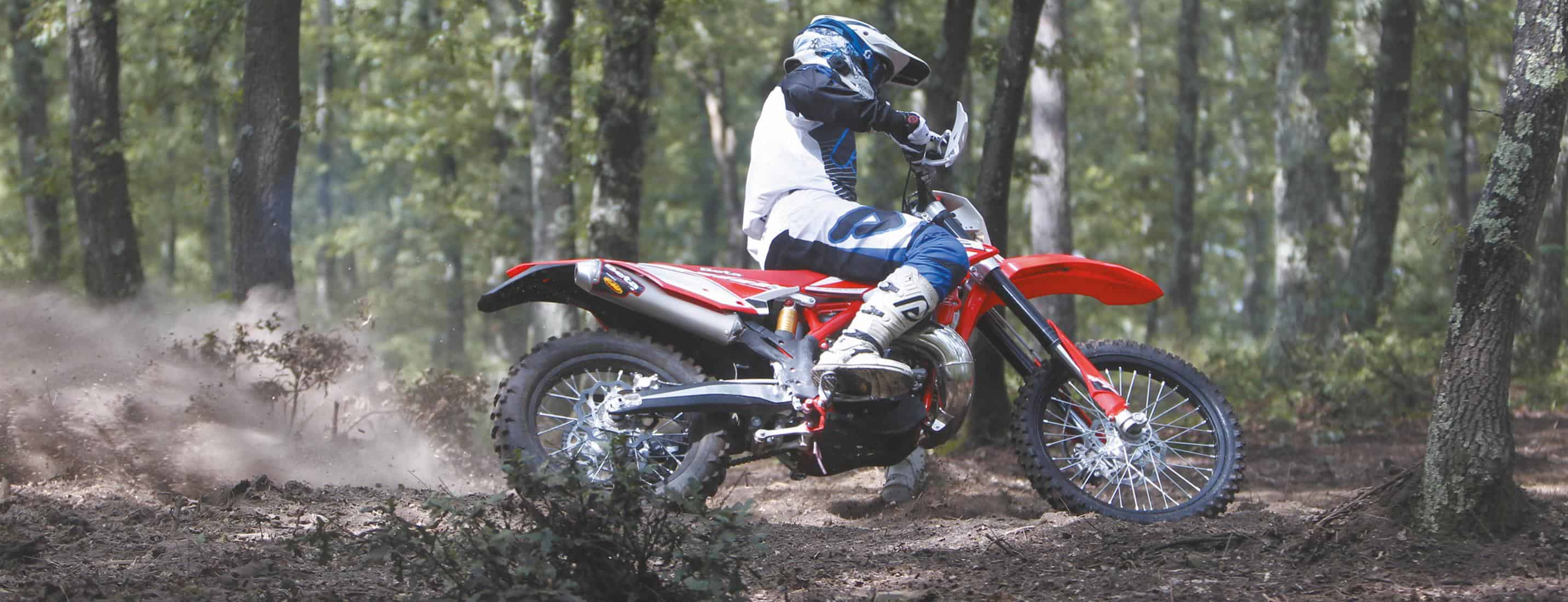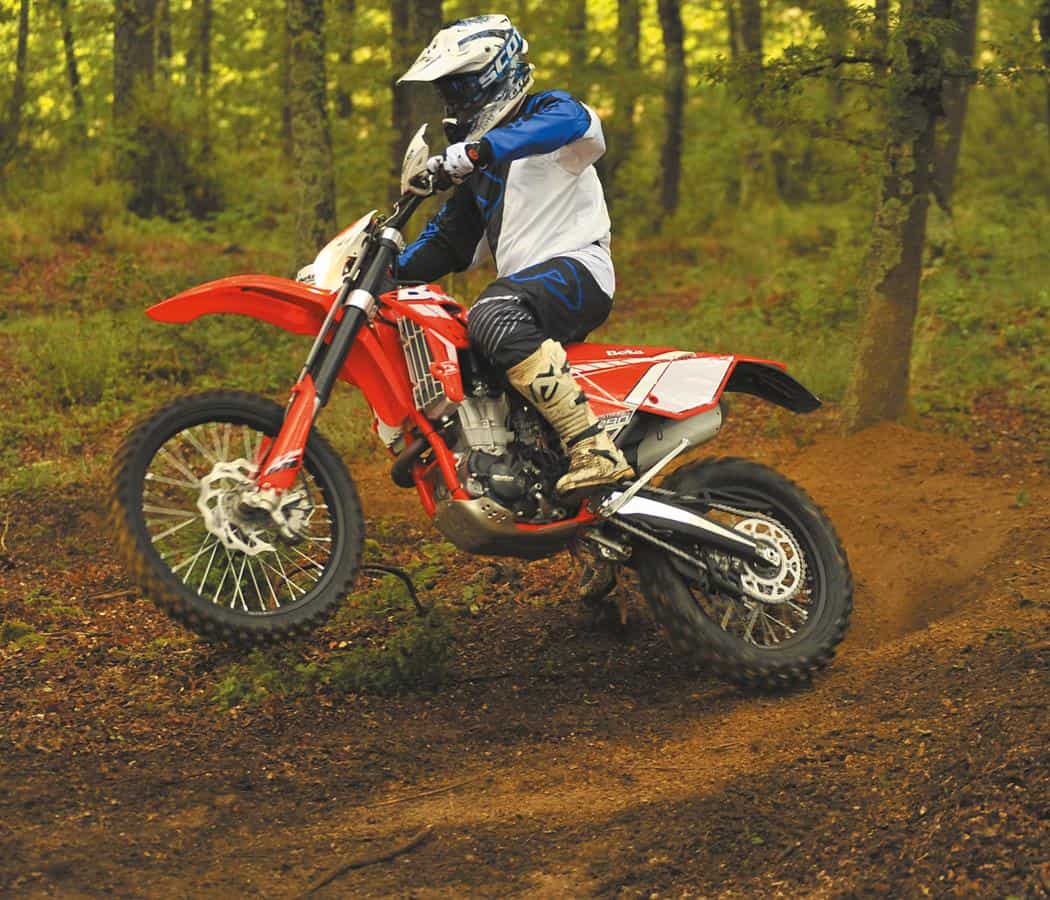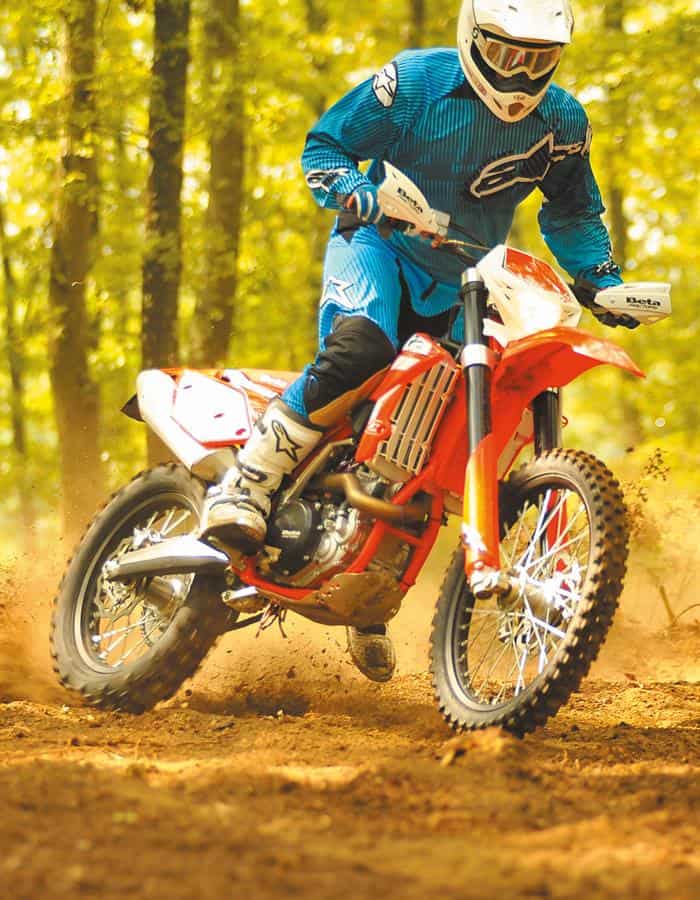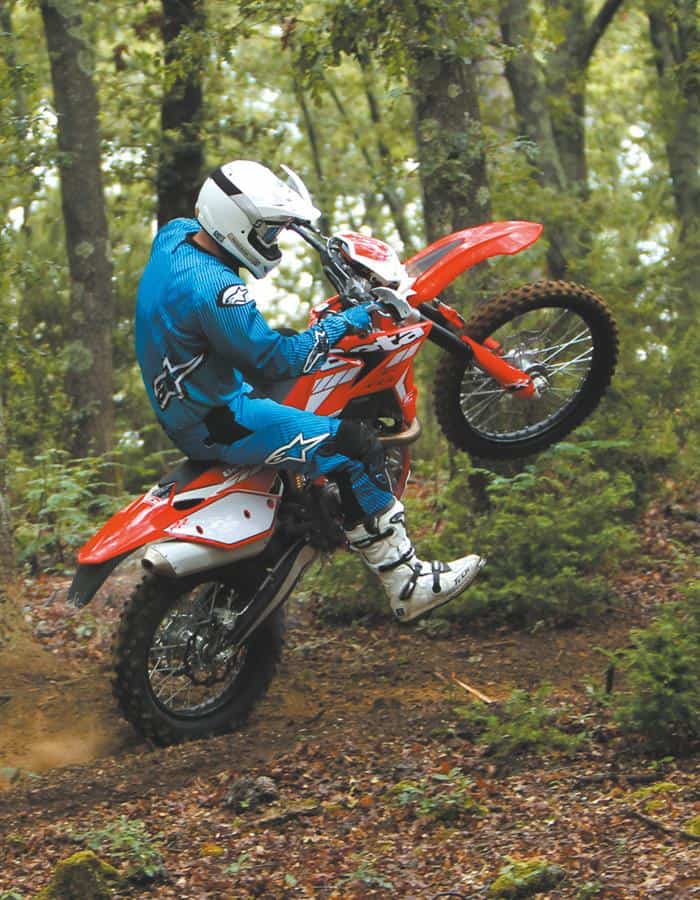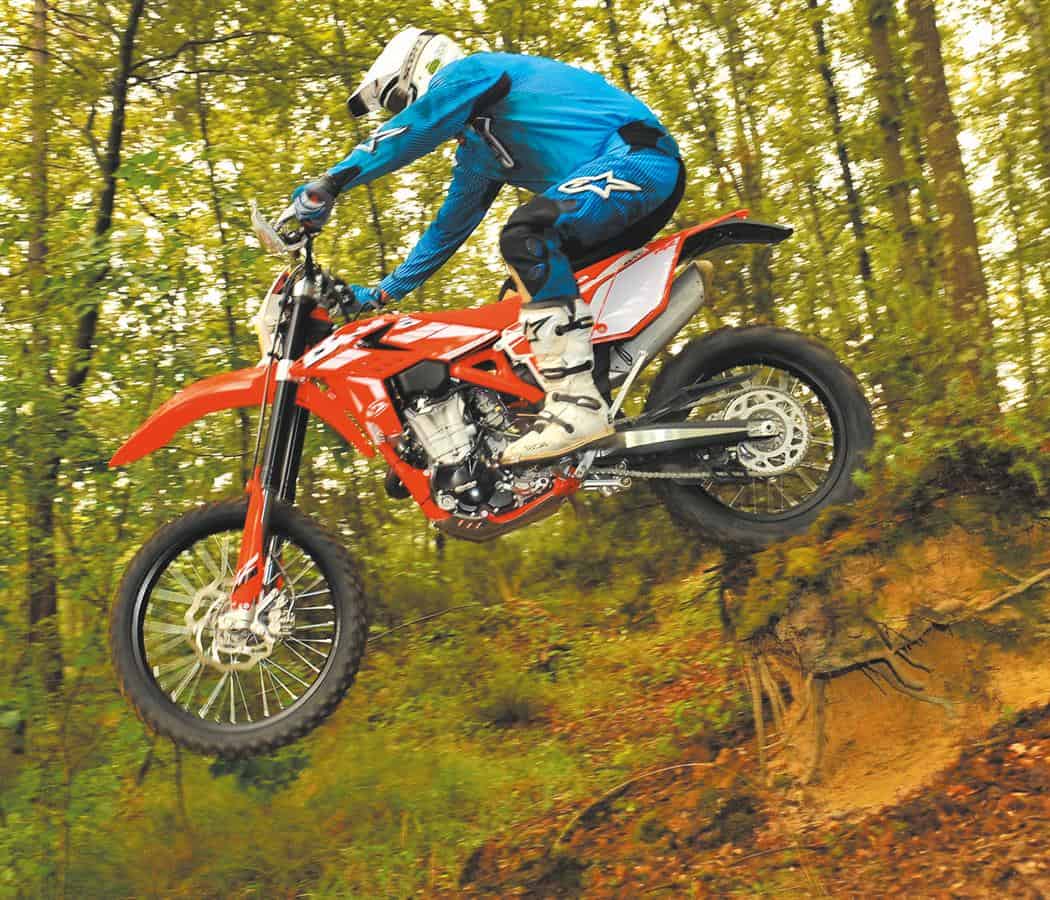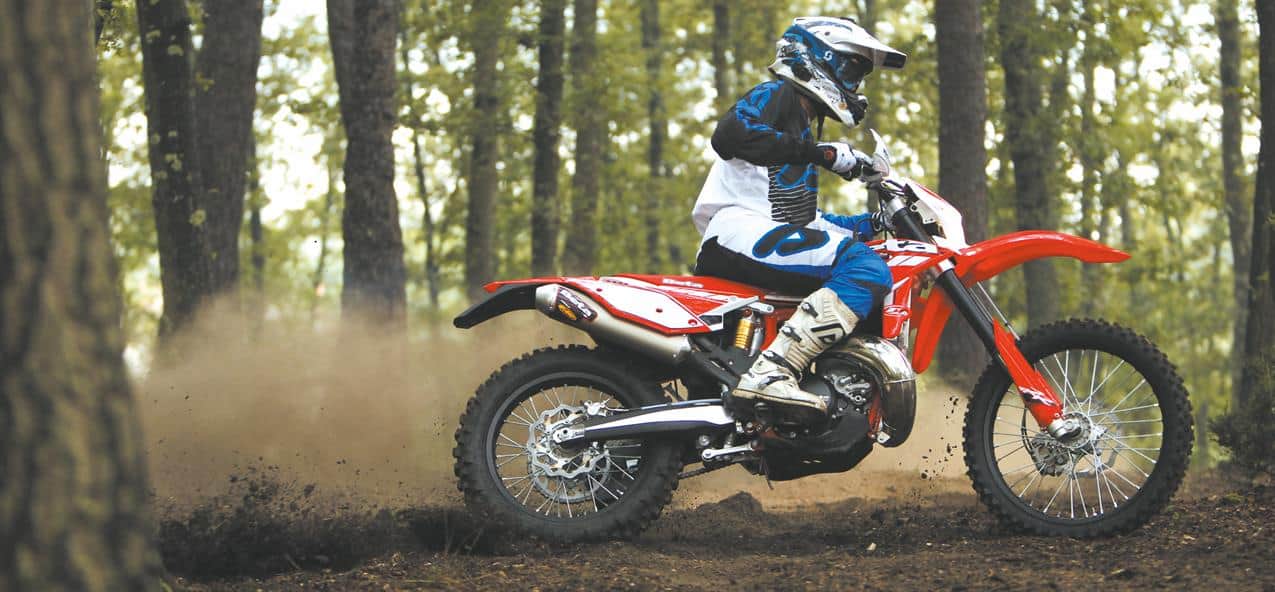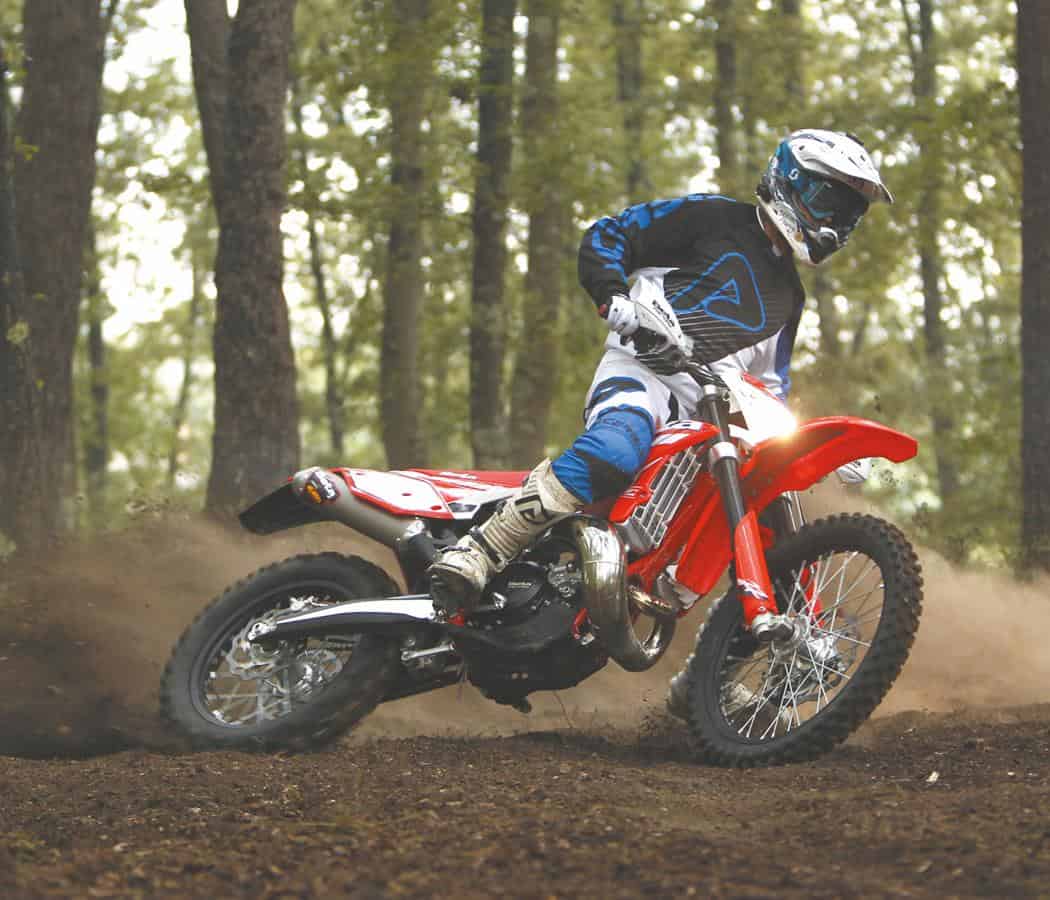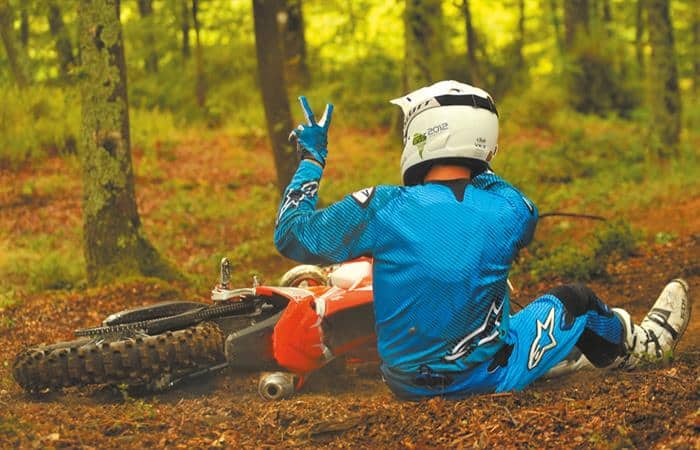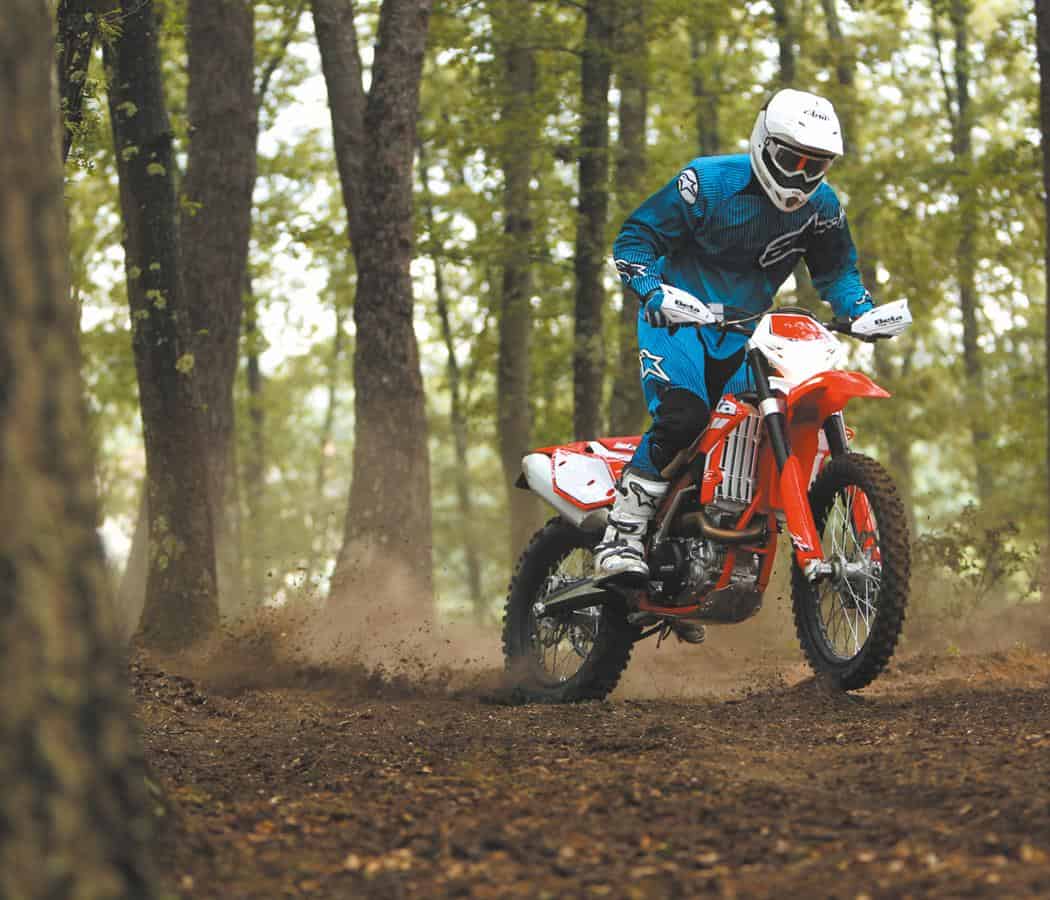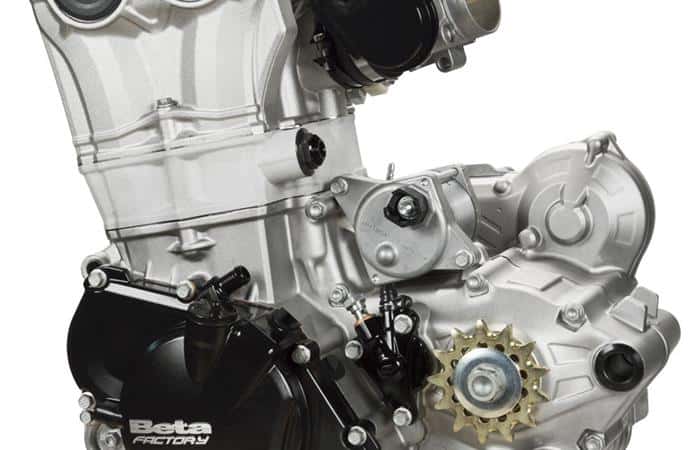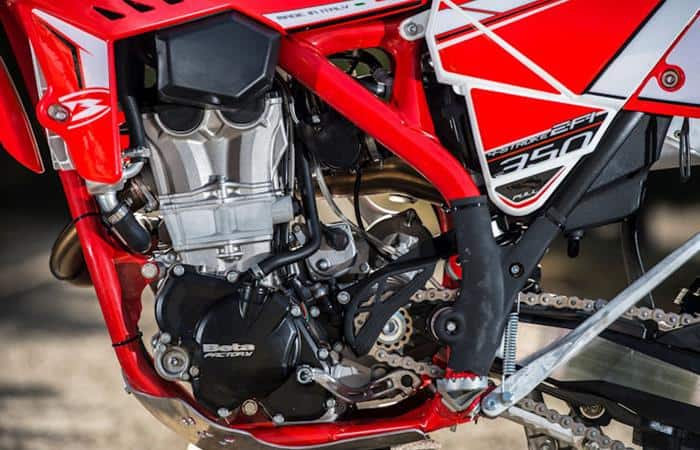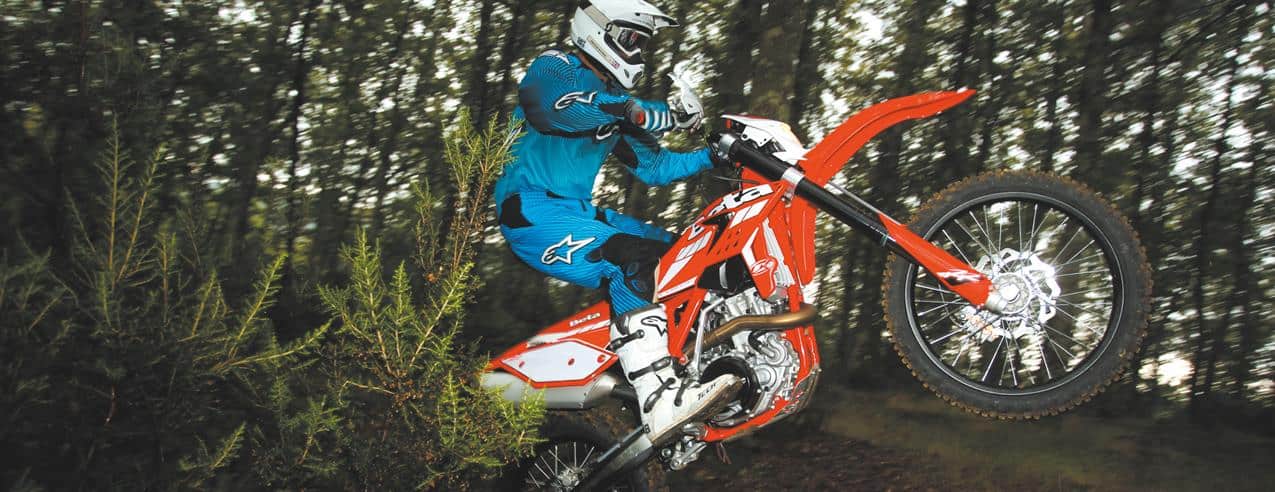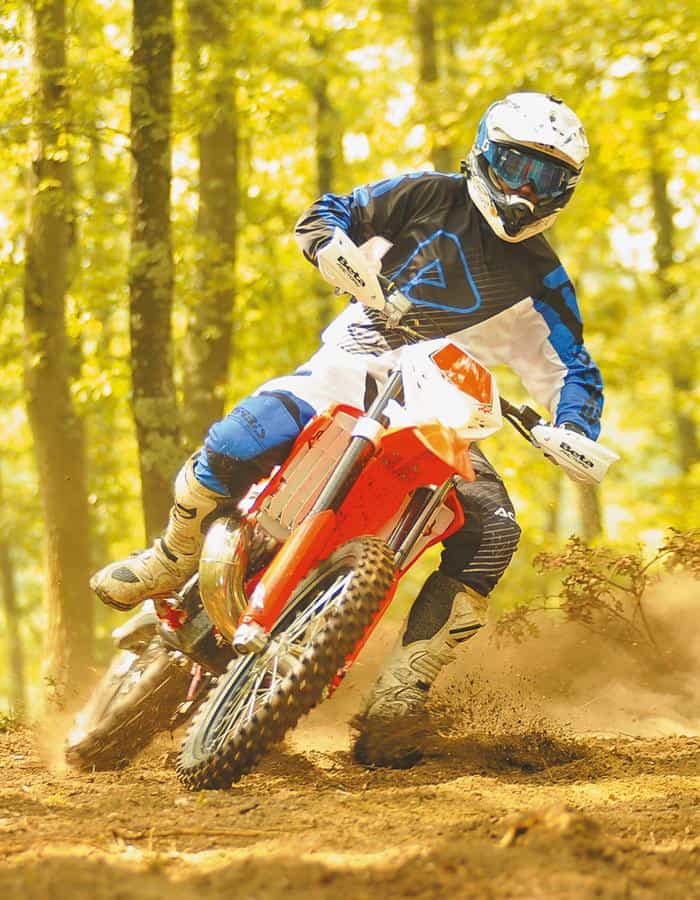Rust Sports went to the 2015 Beta launch and found some significant upgrades and some pleasant surprises…
For a long while now things in the dirt bike world have been tracking on a very straight path. Ever since the introduction of highly competitive four-strokes, innovations have been small and progressive for the best part of 15 years. Leaps and bounds, big advancements or dramatic changes just haven’t really happened, and as a result we have a market full of bikes that are awesome but kind of similar.
The BMW G450X was the biggest change in direction and we all know how that ended. KTM also continue to push on with development, and with the Freeride and Freeride E we have seen them broaden their horizons and look for progress in other areas. These steps always come from the big guns, but for 2015 the relatively small, quiet and safe manufacturer that is Beta have gone a long way left of centre.
Whilst the expected news was that there may just be some EFI coming to the range, the resulting information was slightly more dramatic. The Italians have essentially lost a load of cubic centimetres from their cylinders, meaning the three big four-strokes in their range are smaller than everyone else’s.
The Technical Info
Beta have had a big year in the R&D department. At some point the suggestion of reducing con-rod size was thrown into the melting pot and the Italians ran with it. They built one bike, tested it and decided that was the direction they would head. The end result is a 400 becoming a 390, the 450 becoming a 430 and 498 becoming a 480.
So what is the point of that I hear you ask? Well it’s actually something that makes a lot of sense. Beta have reduced the length of the conrod so the piston size has remained the same, it is just moving less distance vertically. The idea is to reduce the internal weight of the rod, therefore reducing the intertia of the engine. It also lowers the vertical height of the engine, creating a slightly lower centre of gravity. In theory, less inertia makes for a bike that is easier to turn and therefore will feel lighter to ride. Without an engineering degree to argue otherwise at least, it makes sense.
However they haven’t gone down this route with their 350. The 350, Beta argue, is an ideal size. The perfect size for a race bike and so the advancements this year come in the form of something almost as important. Say hello to electronic fuel injection. This has been a long, long time coming for the Italian company. People around the world have been calling for it, they’ve been the only big company running carbs on the their four-strokes for a long while and they’ve been steadfast in their decision to stick with them. However, they are being forced to change their mind by the Euro regulations and as such have entered the market with something a lot different.
Stand up Synerject, the French fuel injection brand taking euro bikes by storm. Whilst the rest of bike world is in love with Keihin, last year rival brand Sherco popped a slightly different unit onto their SEF300. That’s the very same route Beta have taken, but unlike Sherco, they’ve gone one step further. Y’see, the Synerject EFI is a pretty snazzy piece of kit. As well as doing a great job of fuelling motorcycles it has a stepper motor system that wasn’t very well explained by the technicians. However, essentially it allows the tuner, in this case Beta, to control the amount of engine braking a four-stroke produces. So they can if they want, increase or more importantly decrease the amount of engine braking the bike produces. That is big news.
Beta haven’t stopped there with the updates either. All the four-stroke models have been given new lighter crankcases that are now die cast to make them both stronger and stiffer. Between the new conrod and cases the engine weight is down by over a kilo on the 430/480 and 1.5 kg on the 350 and 390.
The piston design is new on the thumpers too, using a lighter, ‘box-in-box’ F1 style piston, with the aim of reducing engine vibration and improving both longevity and performance. They’ve also re-profiled the cams, added a DLC gudgeon pin, redesigned the head and cylinder water jackets and redesigned the balancer shaft to work with new crankshaft. Essentially they’ve kept the same rough design and completely rebuilt it.
The extremely well received two-strokes have also gotten a little loving. Smoothness of power delivery is a common theme amongst all the brands this year and Beta are no different. To help produce a smoother delivery from their bike, Beta have added a second spring to the powervalve to help it open more progressively. On the 250RR, Beta have also reduced the internal width of the silencer to create a more direct throttle response and increase the RPM ceiling.
The 300 gets the engine from the 2014 Race edition, meaning it has a slightly different cylinder with a reduced width exhaust port and a better sealing powervalve. These are intended to improve throttle response and create a more linear power. It also gets a new combustion chamber (exhaust) and CDI.
And that brings us to suspension. It’s been the Achilles heel of the Beta range and the Italians are working with Sachs to improve the quality of the kit. All the bikes receive the same updates, with a new piston design in the shock and forks and a new design of bushes in the fork. In the shock the new piston is aimed at reducing overheating by improving the flow of oil. The setting of the forks has been modified to make it more ‘precise’ too (more on this later).
Add in a softer seat foam, some BNGs and a lovely bar pad and the list of updates is complete. Clearly Beta haven’t exactly been twiddling their thumbs.
The Ride – 2Ts
The first thing I notice when I hop onto the new bikes is just how much I like the chassis and ergos set-up. It’s such a positive design, going from standing to sitting in corners you always end up in the correct place on the seat. There is nothing unusual about the ergos on Betas, they don’t have any quirks in this department. The relationship between the bars, the footpegs and the seat are all perfect – it really stands out – and on the two-strokes I felt like I could instantly carry my maximum corner speed.
The position your body naturally sits on the bike seems to get the maximum from both tyres without much input too. The feel from the front and rear wheel is very planted and you never get the impression one or the other is going to lose grip. It’s more as though if there is grip to be lost, it’ll happen because the grip has simply run out. No excuses.
Beta really have done an incredible job with both the two-stroke engines. I feel like they are the most linear two-strokes engines that I’ve ever ridden. Things haven’t really changed all that much over the last 15 years in two-strokes – the basic design is the same – but all the manufacturers have got very good at refining the settings, improving the power valves and the carburation. Beta have done the best job of this. They are getting more linear, better power than anyone else.
Both the two-strokes have a dead flat powerband. It’s smooth from bottom to top and it’s got bags of power too. Without riding them back to back against the competition it’s hard to say if they’re any more powerful, but they certainly feel it. The key point of the engine however is just how linear and useable that power is… it’s doesn’t feel like it has any flat spots or lumps and bumps. from the seat of your pants it feels like the power curve on the dyno would be a dead flat line. It means that getting the power to ground is easy, in the flat grassy corners it made it easy to roll on the throttle almost like you would on a four stroke, without having to use too much clutch, worry about gears, gear selection or be in the right part of the revs. The engines are just awesome.
We also had a little fiddle with the powervalve spring tension, going half a turn more (clockwise). It improved the delivery on the 250 even more, making it smoother and broadening the power spread. Up until that point I’d preferred the 300. But tweaking the 250 made it more 300-esque and for me made them much closer in performance.
One of the best features of the Beta two-strokes is their ability to pull a wide variety of gears. That butter smooth delivery and huge spread of torque lets you get away with being ambivalent about your gear choice. It’s another facet of the engine that makes it incredibly rider-friendly, especially compared to the competition.
The ride – 350
The 350 is the bike that Beta quite openly see as their race bike. That’s the sole reasoning for the 350 being graced with an EFI system before the other models. On top of all the other changes – the new cases and piston – the 350 receives the bottom end that was exclusive to the racing edition from last year.
Beta really need a pat on the back for the little bike in their range. It’s almost unheard of for a company to join the EFI game and not have some quirks or niggles; but on first impressions the Beta simply doesn’t have them. It’s unbelievably well sorted, you wouldn’t know that this was Beta’s first injected enduro bike – or in fact that it wasn’t still on a carburettor. It has no coughs, no flame-outs or flat spots, it’s completely clean throughout the entire rev range and it’s matched up to an extremely good engine.
I’ll be honest, I’m a person that likes an engine with horsepower. Big bikes suit my style, but on the 350 I know within two corners that the bike is getting the absolute maximum from you as a rider. Everything about the bike is superb: the chassis is great and the whole package is amplified by how good the engine is.
The power on the 350 is very neutral, meaning you go into corners with the throttle still open. That means you do everything quicker. On top of that I love the lack of engine braking. It’s an incredible step. One advantage two-strokes have over four-strokes – particularly in typical British enduro riding conditions – has just been eliminated.
The bike rolls so much freer than a normal four-stroke, closing the throttle doesn’t engage that incredible weight transfer that we traditionally associate with a four-stroke and it makes for a much easier, quicker ride in technical terrain. It also stops the bike loading the front wheel when you may not want it to and so you have a much more flowing, natural, speed. You don’t have to force the 350 to go fast like you do with other small four-strokes because it isn’t trying to slow down whenever you shut off the gas.
It’s possibly not quite as fast in a straight line as the KTM/Husky 350 but it sort of didn’t really affect the bike, because it’s so easy to carry speed. While it is – probably – minutely down on outright speed, the Beta engine makes up for it everywhere else. It’s a fabulously easy bike to ride, with a punchy torquey bottom-end that will let you pull tall gears and drag you out of corner, all the while being incredibly manageable and smooth in technical terrain. The superb fuelling has to be a facet in this, because right from the first opening of the throttle it’s amazingly smooth and does exactly what you want. There isn’t the slight hit some EFI systems give, just on the bottom end, nor the miss they sometimes display.
From the bottom the power curve is smooth and consistent all the way through. The result is an ability to almost ride the bike however you desire. If you want to pull gears it’s got no issue with that, and if you want to rev it a bit harder the Beta will remain a happy bunny. As a result of that, the RR is a bike that’ll suit a huge range of riders, from the super keen racer to the placid trail rider and it doesn’t feel like it’ll skip a beat anywhere along the way. Basically, it’s a bloody awesome motorcycle and without a doubt the best bike in the range.
The Ride – 430
That brings us neatly to the new E2 class weapon. In the UK the 450 class size is an odd thing. We don’t really have riding that fits big bikes like this. It’s why 350s and two-strokes sell through the roof. On the continent it’s not hugely different, yet in the world of pro-racing the 450 is king. Beta’s approach is to produce a 450 for the normal guy, the person who isn’t a world-class athlete with incredible bike skills.
And they’ve nailed it… the 430 is a gem. It’s an extremely impressive bike. If you jumped on it without knowing it was a 430 you’d not notice. The only area of the power it felt different (to a full blown 450) was on the top end. Without riding it back to back it’s impossible to make a definitive statement but it’s got superb bottom and mid-range power. In-fact the only time you really noticed it is a little calmer is when you put the throttle to the stop.
‘Fo-Fiddy’s’ haul like nothing else when you do that but the 430 across open fields felt manageable. It is still fast, it’s just not arm wrenchingly so. But realistically that type of throttle opening is not somewhere you spend much time, and in the real world I think it’s actually a positive. In a longer event, a Hare and Hounds or such, it’s probably not going to tire you out as much (or as quickly) and that is a huge positive.
Again the chassis is balanced and neutral. You never feel like the wheels are going to wash out. It’s easy to turn, planted and manageable in all situations, on the flat grass, the tight woods or in loose rocky turns I always felt it was easy to put the bike where I wanted it. The handling was extremely confidence inspiring. It seemed to push the front a little less than expected, too. It’s controllable and nimble, no matter what’s happening.
So it’s a unique bike that really works. To all intents and purposes it’s not really down on usable power but it is very easy to ride. Beta have essentially made a 450 without the elements that normally beat you up and that’s pretty damn cool.
The Ride – 390
So where does that leave the 390? The 390/400 capacity is an odd thing to my way of thinking. Once upon a time it made sense (there used to be a 400cc class in enduro). KTM built one for aeons and then stopped, started and stopped again. Beta have done well with their own one, sales-wise. However, it’s an odd bike to ride. Honestly, it seems slightly pointless. At the moment when sat next to the rest of the range it doesn’t really work. It doesn’t do anything outstandingly, especially sandwiched between the excellent 350 and lovely 430.
It doesn’t have the grunt or horsepower of the 430, which is great for both racing and trailriding. Likewise it lacks the handling prowess of its little brother – it feels almost like the 430 in the way it turns – but without the advantage of the useable, lovely torque. It’s just a slightly flat, confusing bike to ride. It’s the one bike in the range I got off and wasn’t motivated to get back on.
It’s hard to pin who it’s really aimed at too. I mean it’s not going to be as fun as the bigger bikes to trail ride, and it’s not going to work exceptionally well a race bike either. It is a conundrum. You however, may have different ideas…
The Ride – 480
The big bore of the range is a really fun bike to ride. It’s the same with a lot of the bikes in that class. Every time I ride one I have a big smile on my face. They have some much torque, make so much progress and are so easy and fun to ride that you can’t help but enjoy it. The 480 is a capable bike and can undoubtedly tackle difficult terrain… as long as you aren’t expecting that to be your regular riding.
For racing it is still a big bike. You can’t really get around that fact, and as such you have to take a different view of the situation. It’s a grin factor bike that is great for skids and power wheelies; lovely for cruising around on enjoying life. But you have to remember that when you arrive on that startline of a race, you aren’t gonna’ find it as easy as people on smaller bikes.
Because it’s a bigger bike you naturally don’t push so much and as such the 480 never felt like it was much of a handful to ride. It does turn well and feels like it will only really overcome you once you get tired. Around the type of test track we had I wouldn’t be surprised if the times on the 480 weren’t actually far off the 430, but it’s going to get harder to ride with fatigue. That’s just a fact of life. It was still an extremely fun bike to ride – I really enjoyed it – and for a big bore bike it’s pretty damn manageable.
It’s also the bike I also had the least issue with the suspension on too. Being able to use the torque and the natural inertia of the bigger engine worked in the 480’s favour. There is also an element of: it works because you aren’t ever really trying to cut the fastest line through each corner and so the wallowy nature is less of issue. But more on that now…
Suspension
As great as the Betas are, there is a rather hefty flip-side. The absolute weak point is – I feel – the suspension. It’s the antithesis to the rest of the bike. All of which feels like a high quality, well thought out machine. The suspension however, lets the package down in its standard trim.
Whilst a lot of people set suspension up for their personal ability and desires, not everyone does that, and so straight out of the box it just isn’t right. It began to show up more and more as the track cut up too. There were several sections of our test track – a track that really was surprisingly typical of a UK event – where a few braking and suspension bumps formed that were frankly, scary. You had to be really precise with your positioning on the bumps or else it felt like it was going to eject you into the trees.
You shouldn’t have that feeling. It should be able to deal with these things. They weren’t huge sand whoops, just typical smallish bumps and it was putting the Sachs units in a whole world of pain. It was like both the forks and shock had limited damping control in either direction. As soon as you hit any bump that was bigger than just the spring could deal with, the bike wallowed around and tied itself in knots.
It was never anything more than adequate, and didn’t feel like anything was well controlled. Often soft suspension is nice for the trail rider and not so nice for the racer, but in it’s current set-up the Sachs isn’t working well in that situation either. It’s a disappointment because I like EVERYTHING else about the bike. I like the brand and their values concerning bike design. But it’s a simple fact that to my way of thinking, the suspension isn’t up to the job straight out of the box.
Now that’s not to say that you can’t get the Sachs units working well with some knowledge from tuners in the know. But whether it’ll be as good as other brands is something I can’t answer. Maybe that’s where the racing version would come into its own, but it’s something they need to work on.
Conclusion
All up the Beta range is exceptionally good – let down by inadequate suspension. The engines are all really good, the chassis is extremely neutral and feels natural, the brakes are good, the grab handles, the seat and plastics are all positive and Beta are improving things all the time. We even know from our 2013 long-termer that the build quality is good, but the suspension is a hefty issue.
That said, there is a rather decent upside. Beta’s are cheaper than all the competition and by enough that you could get your suspension re-valved and have change to spare over a KTM, Husky or Sherco and that’s pretty good news. Beta have some aspects to their bikes that are better than the competition right now, and if they put as much development into suspension as they do into perfecting fuelling and power delivery, then they’d be in a very powerful position.
Would I buy one? Definitely, but I’d either opt for the Marzocchi-forked version (though it still has a Sachs shock I believe), or else budget for a complete re-valve. It’s not like you can’t ride the bikes on stock suspension, but these bikes are so damn good, you just know they have a lot more to give with sorted suspension underneath them…
There are many more issues of RUST Magazine for your perusal just click on the link and enjoy! https://rustsports.com/issues/
To see the test of the latest 2018 Betas, click below for the RUST Special Issue…

